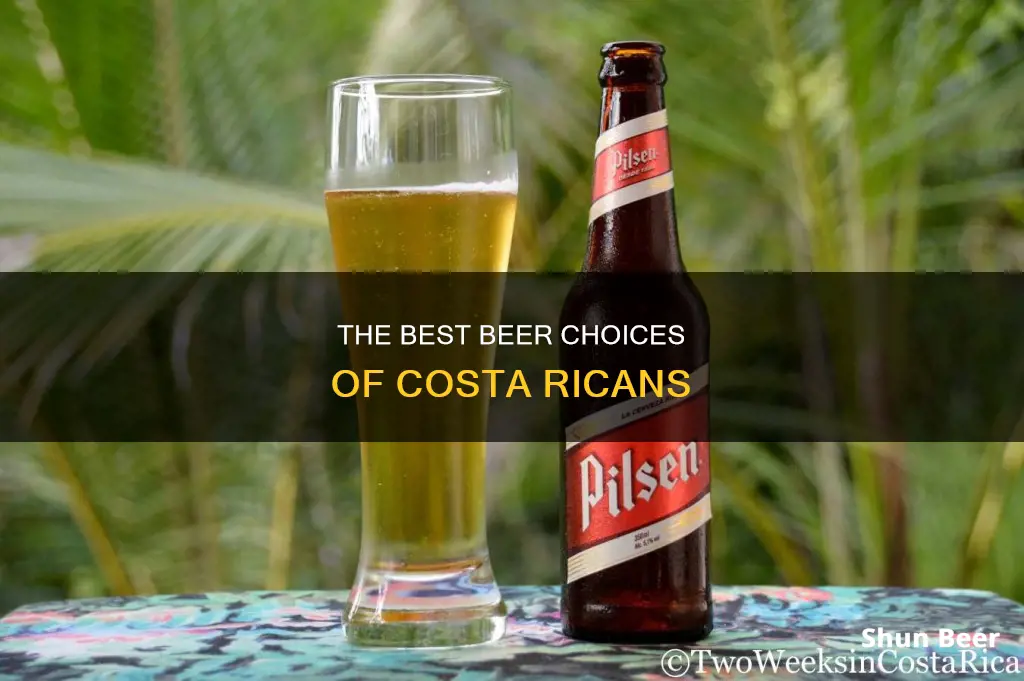
Beer is the most popular alcoholic drink in Costa Rica, and it can be bought even in the most remote places. The most famous Costa Rican beers are Imperial, Pilsen, Bavaria, and Rock Ice. Imperial is the most popular, and is known as the cerveza of Costa Rica. It is a light lager, with an alcohol content of 4.5% and comes in several variations: light, silver, ultra, normal, and non-alcoholic. It is produced by the Florida Ice & Farm Company (FIFCO).
Pilsen is Imperial's little sister, with a slightly higher alcohol content and a more bitter taste. It is the second most popular beer in Costa Rica.
Bavaria is slightly more expensive and comes in three versions: Light, Gold, and Masters. It tastes similar to Imperial but is a little lighter.
Rock Ice is infused with lime flavour and is popular with younger drinkers as it tastes like alcoholic juice.
Craft beer is also growing in popularity in Costa Rica, with microbreweries appearing across the country.
| Characteristics | Values |
|---|---|
| Most popular beer | Imperial |
| Second most popular beer | Pilsen |
| Other popular beers | Bavaria, Rock Ice, Heineken, Budweiser, Corona |
| Local beer price | 6-pack for 5500 colones ($8.68 USD) |
| Craft beer price | $5-8 USD per glass |
| Craft beer bottle price | 900 – 2500 colones ($1.50 to $4.34 USD) |
| Alcohol content | Imperial: 3.5% to 4.6%; Pilsen: 5.1% |
| Variations | Imperial: light, silver, ultra, normal, non-alcoholic; Rock Ice: lime, golden monkey |
| Taste | Imperial: light; Pilsen: bitter |
What You'll Learn
- Costa Rica's most popular beer, Imperial, is a light lager
- Costa Rica's second most popular beer, Pilsen, is a lager with a slightly higher alcohol content
- Costa Rica's craft beer scene is growing, with microbreweries appearing across the country
- Costa Rica's beer industry is centred on mass-produced lagers
- Costa Rica's drinking laws are fairly relaxed, with an age limit of 18

Costa Rica's most popular beer, Imperial, is a light lager
Imperial is the most popular beer in Costa Rica. It is produced by the Florida Ice & Farm Company (FIFCO) and was first introduced in 1924. It is known as the "cerveza of Costa Rica" and is the favourite of many Costa Ricans. Imperial is an American-style lager, with a light and crisp flavour, making it a refreshing choice for cooling down on a hot day. With an alcohol content of 4.5%, it is a relatively light beer that can be enjoyed by almost anyone. The beer comes in cans or bottles, with options such as light or silver variations to suit different tastes.
The Imperial logo, designed by Enrique Hangen, features an imperial Eagle of European design, often found on family emblems and shields. The eagle is also referred to as "el aguila", and due to its prominence, many Costa Ricans simply ask for an "Aguila" or "Aguilita" when ordering the beer. Imperial's advertising campaigns have contributed to its widespread recognition, with the brand sponsoring many events and its logo seen on various merchandise items.
In addition to its popularity, Imperial has also positioned itself as the first water-positive beer. This aligns with Costa Rica's reputation as one of the cleanest countries globally, with a strong focus on renewable resources and an abundance of national parks and reserves. The company conserves water during the brewing process, recycles as much as possible, and provides water solutions to communities in need.
Imperial has several variations, including Imperial Light (~3.5%), Silver, Ultra, Normal (4.6%), and a non-alcoholic version (0%). The availability of different options allows consumers to choose the Imperial beer that best suits their preferences.
Overall, Imperial is a beloved beer in Costa Rica, known for its refreshing taste, wide availability, and environmental initiatives. It is a staple in the country's drinking culture and a popular choice among locals and visitors alike.
Beer and Coughs: Is It Safe to Drink?
You may want to see also

Costa Rica's second most popular beer, Pilsen, is a lager with a slightly higher alcohol content
Imperial is the most popular beer in Costa Rica, but the second most popular beer is Pilsen. With a 5.1% alcohol content, Pilsen is boozier than Imperial, which has an alcohol content of 4.5%.
Pilsen is a lager with a darker flavour and a slightly bitter taste. It is produced by the Florida Ice & Farm Company (FIFCO), which also makes Imperial, Rock Ice, and Bavaria. A 6-pack of Imperial or Pilsen costs around 5500 colones ($8.68 USD).
Pilsen is also the legacy of Pilsen Traube, a beer produced by the Gran Cervecería Traube brewery, which was acquired by Florida Ice & Farm Co. in 1912. The brewery was closed in 1966, but the company continued to brew Pilsen.
Pilsen is a popular choice among Costa Ricans who want more flavour in their beer, as it has a more pronounced malt tang. It is easily recognisable by its distinct red and white label.
Fish and Beer: A Curious Relationship Explored
You may want to see also

Costa Rica's craft beer scene is growing, with microbreweries appearing across the country
The country's first microbrew pub, Cabeza Grande, opened in San Jose in 1998, later relocating to Lake Arenal in 2010 and rebranding as Lake Arenal Brewery, an eco-brewery. In 2010, Costa Rica Craft Beer Co. further jumpstarted the trend with its own brands, "Segua" and "Libertas". Since then, many microbreweries have emerged, guided by expatriate residents from the United States.
The Festival de Cerveza Artesanal (Craft Beer Festival) has showcased the growth of the craft beer scene in Costa Rica. The festival's growth, from 400 attendees initially to around 3000 in 2014, reflects the increasing popularity of craft beer among locals.
By 2014, the emergence of microbreweries prompted Florida Ice & Farm Co., the producer of Costa Rica's famous lager, Imperial, to start its own craft beer division, La Micro Brewing Company. As of 2022, there were around 200 microbreweries in Costa Rica, with a boom in craft beer in the Guanacaste Province.
These microbreweries are spread throughout the country, with many only selling within their town of origin. Popular craft beers include Lake Arenal Brewery in Tilaran, Manada Coyote in San Ramon, and Papagayo Brewery near Liberia, Guanacaste. San Jose has the most craft beer and breweries, and popular tourist destinations like Puerto Viejo, Montezuma, and Guanacaste also offer a variety of craft beers.
The growth of the craft beer scene in Costa Rica has been facilitated by companies like TicoBirra and La Bodega de Chema, which began importing and selling the necessary ingredients, equipment, and tools for brewing. These companies also provide workshops on how to brew beer, further accelerating the creation of new breweries.
The emergence of microbreweries in Costa Rica has provided beer enthusiasts with a diverse range of options beyond the traditional mass-produced lagers. It has also fostered a culture of experimentation and innovation in the country's beer industry, contributing to a dynamic and evolving beer landscape.
Mixing Beer and Hard Liquor: Safe or Not?
You may want to see also

Costa Rica's beer industry is centred on mass-produced lagers
The second most popular beer in Costa Rica is Pilsen, which is a lager with a slightly higher alcohol content of 5.1% and a darker, more bitter flavour. It is produced by the same company as Imperial, Florida Ice & Farm Co., which acquired the Gran Cervecería Traube brewery in 1912, and started brewing its own beers, including what is now known as Pilsen.
Other popular mass-produced lagers in Costa Rica include Bavaria, Rock Ice, Budweiser, and Corona. These beers are widely available in supermarkets, bars, and restaurants throughout the country.
Costa Rica's strong beer industry is, however, not limited to mass-produced lagers. The country also has a growing craft beer scene, with microbreweries spread throughout the country. San Jose, in particular, has the most craft beer and breweries, and there are also several popular tourist destinations known for their craft beer, such as Puerto Viejo, Montezuma, and Guanacaste. The growth of the craft beer industry in Costa Rica can be attributed to the emergence of microbreweries and the increasing variety of beer styles available to consumers.
Snail Solution: Beer Trap's Effectiveness and Efficiency
You may want to see also

Costa Rica's drinking laws are fairly relaxed, with an age limit of 18
Costa Rica's drinking laws are relatively relaxed, with an age limit of 18 years old. The legal drinking age ensures that young adults learn to consume alcohol responsibly. To purchase alcohol, individuals may be asked to present a valid form of identification, such as a passport or driver's license, especially if they appear young.
While Costa Rica boasts a lively drinking culture, it is important to respect local customs and traditions. The country's drinking laws are clear about when and where individuals can buy and consume alcoholic beverages. Alcohol can be purchased from authorised vendors, such as liquor stores and licensed premises. However, drinking in public spaces is prohibited.
The drinking laws in Costa Rica also emphasise the importance of moderation and responsible drinking. Drunk driving, for instance, is strictly prohibited, with penalties including hefty fines and even jail time. To avoid drinking and driving, it is recommended to use ridesharing services or assign a designated driver.
In addition to drinking responsibly, individuals are advised to keep themselves hydrated, especially in Costa Rica's tropical climate. For every alcoholic beverage consumed, it is recommended to drink water as well.
When drinking in Costa Rica, it is also important to be mindful of your surroundings and keep your valuables safe. Always watch your drink to ensure it is not tampered with, and avoid leaving items visible in your car, as this can attract thieves.
Lastly, it is worth noting that Costa Rica has a diverse range of alcoholic beverages to explore, from local beers like Imperial and Pilsen to craft beers and locally made 'guaro'.
Lightest Beer Options: What Are the Best Low-Calorie Brews?
You may want to see also







